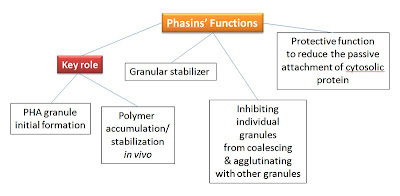- it's spherical shell-core particles composed of polyester core, surrounded by phospholipids and proteins.
 Fig. 1 PHA granule
Fig. 1 PHA granule- Key enzyme for polyester biosynthesis and polyester particle formation: polyester synthase (PHA synthase)
Introduction
- microbes are capable to form inclusions
- inclusions are surrounded by phospholipid membrane
- granules:
- PHA synthase:
 Fig. 3 Classes of polyester synthase
Fig. 3 Classes of polyester synthase
Polyester synthases are the key enzymes
- there are 4 major classes of polyester synthases:
Class I/II
- comprise of enzyme that has only 1 subunit )phaC)
- MW: 61 - 73 kDa
- Class I (R.eutropha): utilise CoA thioesters of various fatty acid
Table 1: Classes of synthase (click to enlarge)

Genetics of polyester biosynthesis enzyme
- genes biopolyester biosynthesis clustered at bacterial genomes
Polyester synthases
- R.eutropha has: homology to enzymes that is related to superfamily of a/B-hydrolases
- method to identify: CD alignment shows amino acid residues' region exhibited 30 % similarity and 17 % identity to the conserved a/B-hydrolase domain
- mutational analysis shows the factors that affect polyester synthase activity:
- this enzyme catalyze: enantio-selective polymerisation of R-hydroxyacyl-CoA thioesters --> polyesters
- non-covalently attached proteins (structural proteins) at the particle's surface
Introduction
- microbes are capable to form inclusions
- inclusions are surrounded by phospholipid membrane
- granules:
- have monolayer of phospholipid
- covalently attached to PHA synthase's surface
- PHA synthase:
- during elongation of PHA (PHA will self assembly during the enzymatic reaction): soluble synthase transformed into amphipathic enzymes
- PHA is covalently attached to the enzyme
 Fig. 3 Classes of polyester synthase
Fig. 3 Classes of polyester synthasePolyester synthases are the key enzymes
- there are 4 major classes of polyester synthases:
Class I/II
- comprise of enzyme that has only 1 subunit )phaC)
- MW: 61 - 73 kDa
- Class I (R.eutropha): utilise CoA thioesters of various fatty acid
Table 1: Classes of synthase (click to enlarge)

Genetics of polyester biosynthesis enzyme
- genes biopolyester biosynthesis clustered at bacterial genomes
Polyester synthases
- R.eutropha has: homology to enzymes that is related to superfamily of a/B-hydrolases
- method to identify: CD alignment shows amino acid residues' region exhibited 30 % similarity and 17 % identity to the conserved a/B-hydrolase domain
- mutational analysis shows the factors that affect polyester synthase activity:
- N terminus: the variable non-conserved N terminus (the 1st about 100 amino acid residued) which could be altered by insertion of SmaI restriction sites & deletion of the 1st 100 N terminal amino acid residues without loosing enzyme activity. thus, this is less important for polyester synthase activity
- C terminus: not in the class III polyester synthase, but in class I & II only, essential in enzymatic activity, hydrophobic suggestic that it interacts with hydrophobic core of PHA granules.




